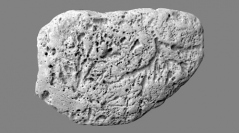

 Comptes Rendus Palevol
11 (5) - Pages 331-344
Comptes Rendus Palevol
11 (5) - Pages 331-344Bioerosion is a common process in hard substrates. This study introduces an example from the rocky palaeoshore cropping out at a sea cliff on the Bozcaada Island. It includes bioerosion trace fossils preserved in limestone boulders of the shallow marine and lacustrine Alcitepe Formation of Late Miocene age. The ichnotaxa include borings produced by duraphagous drillers (Oichnus isp.), phonorids (cf. Conchotrema isp.), clionid sponges (Entobia cf. goniodes, Entobia geometrica, Entobia laquea, Entobia ovula, E. cf. solaris , Entobia isp.), endolithic bivalves (Gastrochaenolites torpedo, Gastrochaenolites lapidicus, Gastrochaenolites isp., Phrixichnus isp.), polychaete annelids (Maeandropolydora isp., Maeandropolydora sulcans, Maeandropolydora decipiens, Caulostrepsis taeniola, Caulostrepsis isp.), echinoids (cf. Circolites isp.) and spinculid worms (cf. Trypanites isp.). Barnacles are also common as encrusters. The borings can be ascribed to the Gastrochaenolites - Entobia assemblage, which is typical of Neogene rocky-shores. They belong to the Entobia ichnofacies indicating various conditions of light, energy, and depth. Therefore they can reveal environmental changes and play an important role in forming palaeo-rocky shores and wave-cut platforms during marine trangressive events.
Bioerosion, Rocky-shore, Trace fossils, Late Miocene, Bozcaada, Turkey